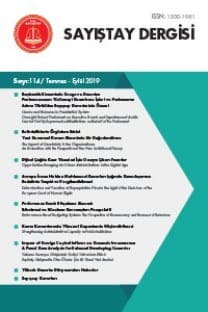Kamu Mali Yönetiminde İyi Yönetişim İçin Sayıştayların İletişim Kapasitesinin Güçlendirilmesinin Önemi
İletişim, Sayıştay Yüksek Denetim Kurumları, Saydamlık
IMPORTANCE OF STRENGTHENING COMMUNICATION CAPACITY OF SAIs FOR ENSURING GOOD GOVERNANCE IN PUBLIC FINANCIAL MANAGEMENT
___
- Anam, Mahfuz (2007), “Media and Audit: Strengthening Peoples’ Right to Public Resource Management”, Auditing for Social Chance: A Strategy for Citizen Engagement in Public Sector Accountability, United Nations Publications, New York.
- Barrett, Pat (2000), “Developing an Effective Approach to Public Auditing”, www.anao.gov.au/uploads/documents/Developing_an_Effective_Ap proach_to_Public_Auditing.pdf .
- Coronel, Sheila S. (2003) “The Role of the Media in Deepening Democracy” http://unpan1.un.org/intradoc/groups/public/documents/un/unpan 010194.pdf
- Dye, Kenneth (2009), “Working with the Media to Maximize the Impact of Your Audit Work”, International Journal of Government Auditing, January
- González, Belén and Antonio Garcia Roberto López (2008), “Supreme Audit Institutions and their Communication Strategies”, International Review of Administrative Sciences, 74 (3) (September).
- González, Belén-Diaz, Roberto Garcia Fernandez, Diaz, Antonio López (2011), “Communication as a Transparency and Accountability Strategy in Supreme documents/D/Gonzalez-Diaz-Garcia-Fernandez-Lopez-Diaz.pdf
- IFAC (2003), Rebuilding Public Confidence in Financial Reporting: An International Perspective, International Federation of Accountants, New York.
- INTOSAI Capacity Building Committee (2010), How to Increase the Use and Impact of Audit Reports: A Guide for Supreme Audit Institutions.
- INTOSAI Capacity Building Committee (2007), Building Capacity in Supreme Audit Institutions: A Guide.
- Krafchik, Warren (2005), “The Role of Civil Society Organizations in Auditing and Public Finance Management”, Auditing for Social Change: A Strategy for Citizen Engagement in Public Sector Accountability, United Nations Publications, New York.
- Nino, Ezequiel (2010), Access to Public Information and Citizen Participation in Supreme Audit Institutions (SAI) – Guide to Practices, World Bank Governance Working Paper Series.
- OECD (2005), “Public Sector Modernisation: Open Government”, Policy Brief, Organisation for Economic Co-operation and Development, February.
- Ramkumar, Vivek (2007), “Expanding Collaboration Between Public Audit Institutions and Civil Society”, International Journal of Government Auditing, April
- Saghal, Vinod (1998), Strengthening Legislative Audit Institutions: A Catalyst to Enhance Government and Combat Corruption, Performit, January.
- Termini, Valeria (2010), Principles and Values of SAI’s Independence For Public Administrations, Conference on Strengthening External Public Auditing in INTOSAI Regions, Vienna, 26-27 May 2010
- UN/INTOSAI (2009), INTOSAI: Active Partner in the International Anti- Corruption Network; Ensuring Transparency to Promote Social Security and Poverty Reduction, Report on the 20th UN/INTOSAI Symposium on Government Audit, Vienna, 11-13 February 2009.
- ISSN: 1300-1981
- Yayın Aralığı: 4
- Başlangıç: 1990
- Yayıncı: T.C. Sayıştay Başkanlığı
Türk Kamu Yönetiminin Dönüşümünde Etkili Bir Araç: Avrupa Birliği İlerleme Raporları
Sayıştayın Denetim, Yargılama ve Raporlama Görevleri Açısından Kamu Zararı Kavramı
Savunma, İstihbarat ve Güvenlik Kurumlarında Taşınır Mal Yönetimi ve Sayıştay Denetimi
Şahin BİNİCİ, Sinan ÇALIKOĞLU, Sayıştay BAŞDENETÇİSİ
Avrupa Birliği Bölgesel Politikalarında Akdeniz Havzası ve Türkiye
